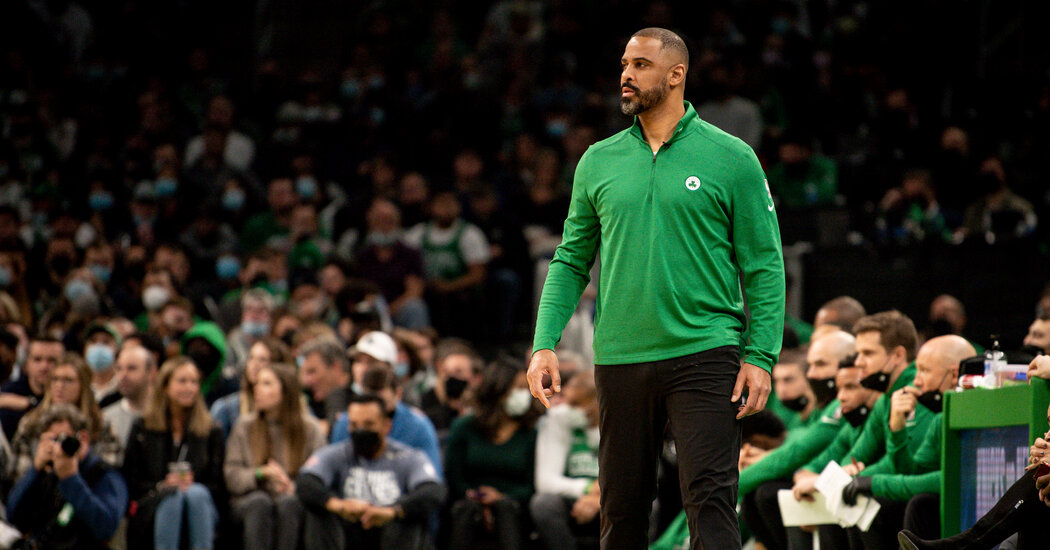
BOSTON — Ime Udoka was always willing to offer instruction. But his players sensed that there were limits to how much he felt he could teach them. Sometimes, he needed to show them.
So Udoka would hop on the phone and summon old friends from the neighborhood. These were former high school teammates, hoopers he knew from the playgrounds and even a few pals who had played overseas. The request from Udoka became a familiar one: Could they swing by practice and toughen up his guys?
“They were older, stronger and smarter, and they would just run us off the court.” said Mike Moser, who played for the first team that Udoka coached. “But you’d learn.”
As Garrett Jackson, another former player, put it: “They’d punk us.”
Udoka, 44, has since made a splash in his first season coaching the Celtics, whose Eastern Conference semifinal series with the Milwaukee Bucks was tied at a game apiece ahead of Game 3 on Saturday. But back when Udoka was still roaming N.B.A. courts as a defense-minded forward, he was already plotting his future — by coaching a bunch of teenagers in his spare time.
For four summers, from 2006 to 2009, Udoka patrolled the sidelines for I-5 Elite, an Amateur Athletic Union team that he helped launch in Portland, Ore. For Udoka, it was a formative experience and set the foundation for everything that followed.
“I got the bug being around those young guys,” he said.
With I-5 Elite, Udoka jumped into drills. He laundered his players’ dirty socks. Talent, he told them, was not as important as effort. Alongside Kumbeno Memory and Kendrick Williams, two childhood friends who ran the team with him, Udoka shaped I-5 Elite in his no-frills image. His former players have seen him apply the same blueprint to the Celtics, who blasted the Bucks in Game 2 of their series. Marcus Smart, in his eighth season with Boston, became the first guard since Gary Payton in 1995-96 to win the N.B.A.’s Defensive Player of the Year Award.
“The most important thing I learned from Ime is resilience,” said Moser, now an assistant coach for the women’s basketball team at the University of Oregon. “You can’t really know Ime without knowing what he’s been through and what it took for him to make it to the N.B.A. It’s almost ridiculous when you think about it.”
Udoka grew up in Portland obsessed with basketball, a student of the game who skipped his prom to play hoops. He emerged as an N.B.A. prospect at Portland State, only to tear up his knee before the draft. Odd jobs followed, including a stint with the Fargo-Moorhead Beez of the International Basketball Association. After he wrecked his knee again, Udoka spent much of the next year loading trucks for FedEx, hoping for another crack at the N.B.A. He cycled through training-camp invites and 10-day contracts.
When Udoka finally landed with the Trail Blazers in 2006, it was the break he needed and the start of a productive career that included two seasons and part of a third with the San Antonio Spurs. He also pounced on an opportunity when Nico Harrison, a marketing executive at Nike, set aside a few dollars for Udoka to launch an A.A.U. team, Memory said. It was something Udoka had talked about doing with his friends for years, and now they could make it happen. (Harrison is now the general manager of the Dallas Mavericks.)
At the time, A.A.U. basketball was known as a breeding ground for well-funded street-ball games. Udoka, though, was going to do things his way, which meant the hard way.
“We were never just going to roll the balls out there,” Udoka said. “We were going to teach them how to play. Structure, discipline, defense — those were all things I stressed. And that’s how I was as a player.”
Memory and Williams handled the X’s and O’s — Udoka, as strange as it sounds now, was not certified as a coach — but it was Udoka’s program, Williams said. As soon as Udoka’s N.B.A. season ended, he would rush to the airport to meet up with I-5 Elite.
“You’d literally be watching him play on TV for the Spurs, and then he’d be in the gym with you the next morning,” Jackson said.
I-5 Elite’s first recruit was Moser, who, as a 15-year-old forward, was awe-struck that an N.B.A. player — from his hometown, no less — was showing interest in him. Udoka worked with Moser at the Trail Blazers’ practice facility and invited him courtside for games. But Udoka also challenged him. From his spot on the bench, Udoka noticed that Moser tended to stand around when teammates launched shots. Udoka wanted him to pursue offensive rebounds.
“Stop watching, Moser,” Udoka would growl. “Stop watching.”
Moser eventually got the message. (Really, he had no choice.) Later, as a sophomore at the University of Nevada, Las Vegas, Moser emerged as one of the country’s leading rebounders.
There were more talented teams on the national circuit. But Udoka, along with Memory and Williams, squeezed the I-5 Elite roster for every drop of potential. Weekend practices were rigorous. Udoka had a soft spot for role players and glue guys, for scrappers who treated every possession like it was a final exam. One such player was Jeff Dorman. Udoka was always lobbying the other coaches on Dorman’s behalf, even though he was playing behind Terrence Ross, who had an N.B.A. career ahead of him.
“Dorman was an unsigned senior,” Memory said, “and Ime would be like: ‘Put Dorman out there, man. I think he’s got something. Give him a chance.’”
Dorman went on to play at Clackamas Community College, where he was an all-conference guard, and at Seattle Pacific, a Division II school.
Communication, Udoka understood, was not one-size-fits-all. Some players needed more discipline while others needed more encouragement. Some were from the suburbs while others were from the city. So Udoka tailored his approach, seeking to learn as much as possible about each of them. He offered them rides to practice. He ate meals with their families. He knew, even then, that relationships were essential to coaching, he said. But he refused to compromise on his standards.
“It wasn’t hard to get on them and hold them accountable,” Udoka said.
Sometimes, he added incentives. The team, Moser said, was scuffling through an uninspired practice one afternoon when Udoka paused the proceedings: Who wants $100? Winner of the next scrimmage takes the prize.
“And it was $100 per player, man,” Moser said. “Ime was not cheap.”
The temperature in the gym went from lukewarm to molten.
“There were some prison fouls going on,” Moser said. “But that’s how he encouraged us to be — a tough, hard-nosed group.”
Jackson recalled being on the road for a tournament with I-5 Elite when his college recruitment was heating up. Back at the hotel one night, he was on the phone with a college coach who was curious about Udoka: What was he like to be around? At that very moment, Jackson said, Udoka surfaced from around the corner cradling a heap of sweaty uniforms.
“The guy is in the N.B.A.,” Jackson said, “and he’s washing our clothes at the hotel.”
As it became clear to him that he might have a future in coaching, Udoka worked at his craft, attending coaching clinics organized by the N.B.A. players’ union. In 2012, Gregg Popovich, the coach of the Spurs, called to offer him a job as an assistant. Udoka wrestled with the decision: Did he want to close the book on his playing career?
“And it was unusual because he’s usually very decisive,” Moser said. “I remember talking with him about it for hours. And then he just kind of decided: ‘You know what? I’m going to do it.’”
Udoka never looked back. He spent nine seasons as an N.B.A. assistant before the Celtics hired him last summer, and he brought some familiar faces with him. Among them: Jackson, 30, who joined Udoka’s staff as an assistant for player enhancement.
“When he got the job, I knew I wanted to help him,” Jackson said. “I didn’t know what the role was going to be, and I didn’t care. I was like, ‘I’ll do whatever you want me to do.’”

